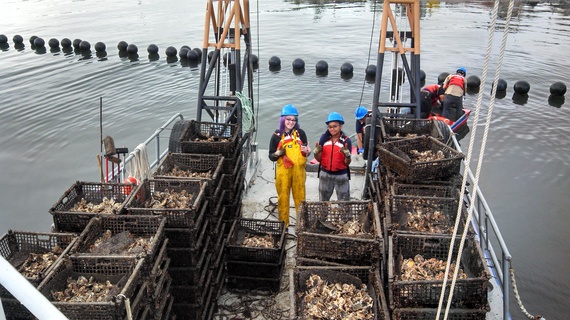Manhattan Oyster Project
Published on by Water Network Research, Official research team of The Water Network in Social
S.T.E.M.+O = Science, Technology, Engineering, Math and Oysters
"How does a city of this magnitude bring young students to the water, and have them feel a sense of ownership and community?" asks Professor Lauren Birney from her lower Manhattan office at Pace University's School of Education.
"Oysters."
A century ago, the oyster was New York's pearl. Oystering was as integral to New York Harbor's identity as the Statue of Liberty. The waters of the city and New Jersey boasted more than 260,000 acres of oyster beds spread throughout the harbor, its bays and estuaries, the lower Hudson and East rivers. New Yorkers ate more oyster meat than beef. The original New York "foot-longs" were Gowanus oysters, gathered from Gowanus Bay and Creek in Brooklyn and exported to Europe as a delicacy.
In present day New York, oysters are better associated with the Oyster Bar in the cellar of New York's Grand Central Terminal, where oysters from Apalachicola Bay in Florida and Chincoteague Bay in Maryland are now the delicacy. Generations of pollution drove out New York oystering, and the name "Gowanus" is identified less with the bay and more with the canal, a toxic, Federal Superfund site (hopefully on its way to a major cleanup).
But the Billion Oyster Project aims to change all that by enlisting hundreds of thousands of city school children to restore a billion oysters to city waters. "In short, students are driving the restoration of New York Harbor," said Birney.
The Billion Oyster Project was the brainchild of the New York Harbor School. Murray Fisher, the school's founder and now president of the New York Harbor Foundation, which helps fund and manage the school's programs, told Grist in 2010, at the project's launch:

There are 1.1 million kids in the New York City public school system and the New York Harbor is still one of the richest water habitats in the world. But it's become very degraded and disconnected from those 1.1 million kids.
With a $5M grant from the National Science Foundation Birney is co-leading a powerhouse group of collaborators to build upon the Billion Oyster Project and target "middle-school students in low-income neighborhoods with high populations of English language learners and students from groups underrepresented in STEM fields [Science, Technology, Engineering and Math] and education pathways."
In addition to the students' hands-on work constructing reefs, growing and planting oysters, maintaining boats and operating monitoring equipment, Birney says the new funding opens up the world of STEM.
The harbor is like a living laboratory for education in STEM. We want to give students the opportunity to learn outside the school building. Our consortium of partners is creating opportunities for citizen science, real-time data collection, operation of monitoring technologies, and more.
After-school mentoring provides extra enrichment for those students especially interested in STEM. Maybe a student gets excited about oysters or the condition of the harbor and decides to be a biologist, or pursue an interest in maritime law. An interest in our monitoring technologies could open a door to the study of engineering. These experiences are such a rarity for our students they may otherwise not have the opportunity to discover their passion.
Source: Huffington Post
Read More Related Content On This Topic - Click Here
Media
Taxonomy
- Coastal Engineering
- Restoration
- Coastal